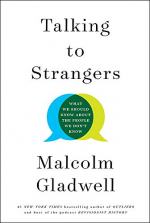|
This section contains 1,143 words (approx. 3 pages at 400 words per page) |

|
Summary
In Part 3, Chapter 6, "The Friends Fallacy," Gladwell describes an episode from the sitcom Friends. He suggests that the actors' transparent facial expressions would allow anyone to mute the show and still follow along. He cites psychologist Jennifer Fugate's considerations of the Facial Action Coding System as evidence. FACS assigns numbers to hundreds of muscular facial movements. With Fugate's help, Gladwell then describes the same Friends episode through the characters' facial expressions. Their demeanors are easy to read, following typical categorizations of emotional expression. Gladwell says real life is different; though people want to believe they can read others, they cannot.
Gladwell then describes anthropologist Sergio Jarillo's and psychologist Carlos Crivelli's studies of emotions. The men traveled to various populous and remote reasons, examining the universality of facial expressions. They found that not every culture interprets emotions the same way. Referencing Patrick Dale Walker's...
(read more from the Part 3: Transparency Summary)
|
This section contains 1,143 words (approx. 3 pages at 400 words per page) |

|




